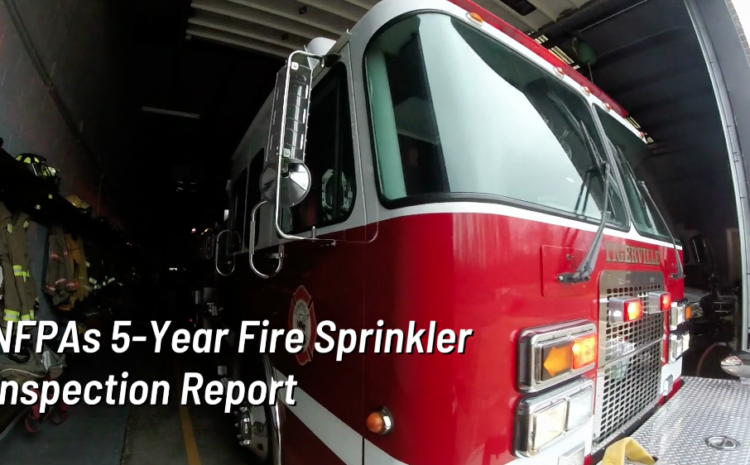
NFPA 25 5-Year Inspection Report
Novita works with its insurance agent/broker partners to assist them in keeping their clients up-to-date with the latest information regarding various property inspections and testing. These inspections – which address potential hazards and overall risk management issues – help ensure properties are in compliance with current standards and regulations and provides necessary documentation for insurance submission requirements. Inspections and testing also have the added benefit of mitigating expensive repair costs through driving regular maintenance.
As insurance professionals entrusted with structuring safeguards for your client’s real property assets, you are an important resource and information conduit to your property owner clients. And Novita is committed to keeping you at the fore of insurance best practices, regulations, requirements, and knowledge needed to successfully navigate an ever-changing insurance landscape.
This week, Novita kicks off a series on property hazards and inspections, starting with the 5-year NFPA 25 Fire Sprinkler Inspection Report. When a commercial property insurance provider requires proof of fire safety compliance they are most often talking about the NFPA 5-Year Fire Sprinkler Inspection Report. We delve into recommended and required fire sprinkler system inspection schedules, testing schedules, and ongoing maintenance to help you underscore the importance of safeguarding real property assets.
Pat Lowther, President and CEO, Novita Insurance Solutions, LLC
When a commercial property insurance provider requires proof of fire safety compliance they are most often talking about the NFPA 5-Year Fire Sprinkler Inspection Report.
Modern fire safety codes and standards trace their origins to the 19th-century development of automatic sprinklers. The NFPA – the National Fire Protection Association – began when a small group of representatives of leading fire insurance and sprinkler interests gathered in Boston in March 1895 to address the growing issue of non-standardized piping size and sprinkler spacing. The members of this fledgling group knew nine radically different standards for piping size and sprinkler spacing could be found all within 100 miles of the city of Boston. They realized this plumber’s nightmare had to be resolved or the rate of sprinkler system failure might prove unacceptable, perhaps catastrophic.
The result of this – and subsequent meetings – coalesced into the NFPA and the development of standardized equipment, piping, installation, and later, testing and reporting. The NFPA started the inspection code requirements for automatic fire sprinkler systems in 2002, known as the NFPA 25 5-Year Fire Sprinkler Inspection Report, a move that helps drive proper maintenance of these critical life safety systems.
The NFPA 25 5-Year Fire Sprinkler Inspection Report
This internal inspection of the pipe is conducted every five years. The 5-year inspection sticker verifies a property’s fire sprinkler is up to code. To keep fire sprinklers working properly, property owners and/or facilities managers perform inspections and testing according to NFPAs baseline for inspection, testing, and maintenance of water-based fire protection systems. Compliance helps maximize system integrity to avoid failure and ensure a fast, effective response in a fire emergency, which is the Standard for the Inspection, Testing, and Maintenance of Water-Based Fire Protection Systems.
It also helps property owners avoid legal fines, reduces the potential for lethal accidents, and helps mitigate expensive repairs, when ensuring all fire sprinkler system components are code compliant.
Property owners should maintain all records of the most recent fire sprinkler inspections and tests for at least one year and be prepared to show these records to service providers, such as insurance carriers, upon request.
What is included in the NFPA 25 5-Year Sprinkler Inspection Report?
This inspection goes beyond the systems, valves and piping, and includes internal examination and testing. At random points in the fire sprinkler system, samples are taken to check for, and identify “MIC” (Microbiologically Influenced Corrosion; corrosion aided by bacterial activity in a sprinkler system. MIC can destroy sprinkler piping at an alarming rate, and byproducts of corrosion can clog sprinkler piping and sprinklers, which may inhibit the system from operating as it was originally designed), rust, and slime that may obstruct the piping and compromise the system, and other organic or inorganic foreign matter).
This inspection is especially important because, although a fire sprinkler system failure is rare, when it does occur it is often associated with a blockage in the system. Materials blocking the fire sprinkler piping can cause either no water – or insufficient water – when a fire sprinkler activates during a fire. The 5-year inspection is the only inspection that ensures there are no blockages in the system, so water flows with the correct pressure.
NFPAs 5-year testing serves as the foundational standards baseline for these tests, with a number of states adding more layers of stricter requirements. As with any property ownership issue, local/regional/state requirements should be consulted and adhered to as required by law.
What does the 5-year fire sprinkler inspection actually entail?
When a 5-year fire sprinkler inspection takes place, a fire protection inspector verifies the operation and condition of check valves and internally inspects the pipe. Internal examination is performed at the aforementioned minimum four points – system valve, riser, cross main, and branch line. Inspectors look for corrosion obstructions – either organic or inorganic foreign matter.
During the inspection, valves are examined to ensure proper operation. Pipes are drained and checked for foreign matter. Additionally, all internal components are cleaned, repaired, or replaced as necessary, according to the manufacturer’s instructions.
The inspection should also address other areas of the system that could cause concern, including valves, gauges, sprinkler heads, water storage, and “FDC” (Fire Department Connection; part of a sprinkler or standpipe system):
• Gauges must be replaced or tested compared to a calibrated gauge.
• Fire sprinkler heads must be inspected and changed where needed.
• The water storage tank should be examined by a licensed industrial diver or distant video if not by the inspector. Your inspector will check for signs of pitting or corrosion, including the tank coating, pinholes, cracks, and overall wall thickness.
• All valves, especially stress lowering, stress aid and fire hose valves should be examined for corrosion or obstruction, adequate pressurization levels, and functioning clappers and seats.
• Internal piping is investigated for obstruction if foreign materials are detected.
• The FDC should also be inspected to ensure that, in case of an emergency, the fire department can hook into the FDC and it is free of obstructive material that may not allow water to pass.
If the presence of organic or inorganic matter (“MIC”) is found within the system, a deeper, more comprehensive obstruction investigation must follow.
Internal pipe examinations for “at-risk” systems take the inspection a step further. At-risk systems – those fifty years and older – need to be monitored and inspected more closely than newer systems. These at-risk systems are also examined at the system valve, riser, cross main, and branch lines.
After completion of the 5-year inspection, the report is completed and submitted to the property owner.
How often should a fire sprinkler system be inspected?
An inspection is essentially a visual once-over to check the status of the sprinkler system. According to NFPA 25, this is the inspection schedule a property owner or facilities manager should follow:
• Weekly or monthly: Inspect the gauges in dry, pre-action, and deluge systems as often as once a week. Wet pipe system gauges can go a month between inspections.
• Quarterly: Every three months, have the water flow alarm devices, valve supervisory alarm devices, supervisory signal devices, control valves, and hydraulic nameplates inspected.
• Annually: Once a year, inspect the hanger/seismic bracing, pipes and fittings, information signage, and spare sprinklers.
• Every five years: Conducting an internal inspection of sprinkler piping is only required once every five years.
How often should a fire sprinkler system be tested?
Tests are comprised of more in-depth physical checks. NFPA 25 dictates a baseline fire sprinkler testing schedule as:
• Quarterly: In order to be as effective as possible, fire sprinkler mechanical devices should be tested quarterly.
• Semiannually: Every six months, vane and pressure switch type devices must be tested.
• Annually: Full testing and tagging should be performed annually. During a complete fire sprinkler system test, the technician should perform physical checks on all parts of the fire sprinkler system. These checks include water flow tests, fire pump tests, antifreeze concentration tests (in applicable systems), alarm tests, and trip tests of dry pipe, deluge, and pre-action valves.
• Every 5 years: Sprinklers exposed to extra-high temperatures and harsh environments, along with gauges on all sprinkler system types, should be tested or replaced every five years. An investigation of piping and branch line conditions is undertaken by opening a flushing connection at the end of one main and by removing a sprinkler toward the end of one branch line to investigate the presence of foreign organic and inorganic material.
• Every 10 years or more: Dry sprinklers should be tested or replaced every 10 years. Fast-response sprinklers should be tested after 20 years in use, and every 10 years after that. Standard response sprinklers should be tested after 50 years in use, and in 10-year intervals after that.
What should a property owner do if the inspection finds corrosion (MIC)?
If foreign material is found in any system in a building, all systems are then assessed, and an Obstruction Investigation follows. If foreign matter is found – a trigger point – complete flushing of the systems is required and removes any obstruction.
Corrosion in fire sprinklers is a major issue. It can change the trajectory of a fire from that of an inconvenience – if the fire sprinklers are activated correctly – to a devastating loss of life, property, and production if the fire sprinkler water source was blocked. By following fire sprinkler inspection requirements, commercial property owners have peace of mind in knowing that their facility and people are safe.
How should your clients prepare for the 5-Year Sprinkler Inspection?
To prepare for the 5-year internal sprinkler inspection and maintain the safety of their facility and its occupants, your property clients need to perform regular maintenance of their internal sprinkler system, replacing and inspecting parts as necessary.
Conclusion
Novita’s team is here to help you secure insurance coverages that address your client’s risk exposure. For additional information, contact us and visit the company’s LinkedIn page
